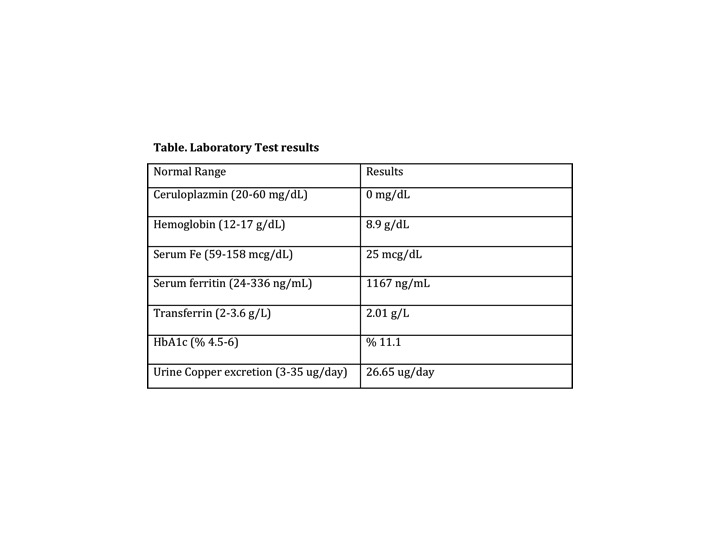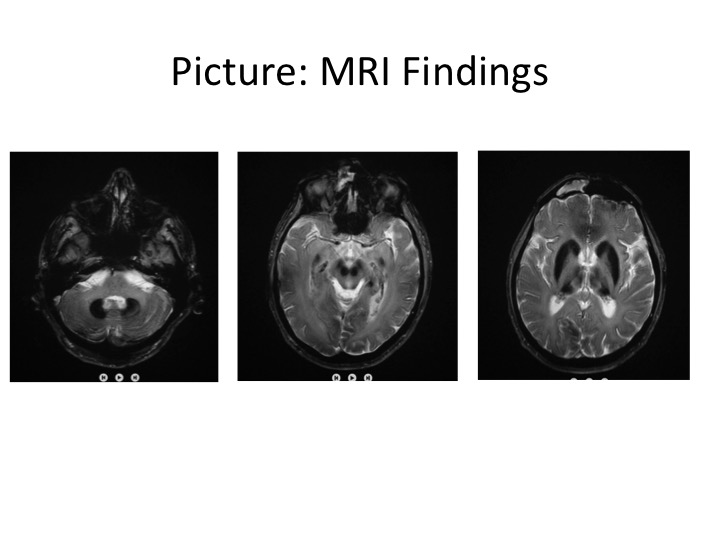Session Information
Date: Monday, September 23, 2019
Session Title: Rare Genetic and Metabolic Diseases
Session Time: 1:45pm-3:15pm
Location: Les Muses Terrace, Level 3
Objective: We describe the phenotype, video-oculagraphic and neuroradiological findings of a case of aceruloplasminemia (AC).
Background: Aceruloplasminemia presents in adulthood and is characterized by microcytic anemia, diabetes, retinal disease, and a movement disorder consisting of facial dystonia, chorea, tremor, parkinsonism, ataxia, and cognitive decline. In addition to anemia, laboratory investigations reveal low or absent serum ceruloplasmin, elevated ferritin, low iron, and low serum copper but normal urinary copper.
Method: Case report
Results: An 49 years old male patient presented with sixth months history of imbalance, slowness, gait difficulty, tremor, cognitive disorder, anemia and diabetes. He is from a first cousin marriage and at the time of examination there is only one affected among eight siblings. The mode of inheritance is consistent with autosomal recessive inheritance. Neurological examination showed hypomimia, mild symmterical bradykinesia and rigidity, resting tremor in the right hand, ataxia and loss of tendon reflexes in the lower extremities. The cognitive tests revealed that the patient has severe memory, orientation, attention and visuospatial abnormalities. The Mini Mental State Examination score was 9 and Montreal Cognitive Assessment score was 15. Electromyographic study showed severe axonal and demyelinating polyneuropathy. Retinal examination was normal. MRI studies revealed iron accumulation in the liver. Brain MRI showed overload of paramagnetic material in dentatus, putamen, caudate nucleus, posterior thalamus and s.nigra consistent with iron accumulation (Picture).Video-oculographic exam showed hypometric vertical saccadic eye movements.DNA sample was sent for CP mutation screening. Laboratory test results is shown in the Table and showed low serum Fe, hemoglobin, transferrin and higher levels of ferritin, HbA1C. Serum ceruloplasmin level was 0 and urinary copper excretion was normal.
Conclusion: Aceruloplasminemia is an ultra-rare hereditary disorder caused by defective production of ceruloplasmin. The patient we present here has typical clinical and laboratory findings and also hypometric saccadic eye movements as demsonstrated by videoculography which has not been reported before.
To cite this abstract in AMA style:
O. Dogu, N. öksüz, H. Kaleagasi. A case of Aceruloplasminemia with vertical saccadic eye movement abnormalities [abstract]. Mov Disord. 2019; 34 (suppl 2). https://www.mdsabstracts.org/abstract/a-case-of-aceruloplasminemia-with-vertical-saccadic-eye-movement-abnormalities/. Accessed April 1, 2025.« Back to 2019 International Congress
MDS Abstracts - https://www.mdsabstracts.org/abstract/a-case-of-aceruloplasminemia-with-vertical-saccadic-eye-movement-abnormalities/


